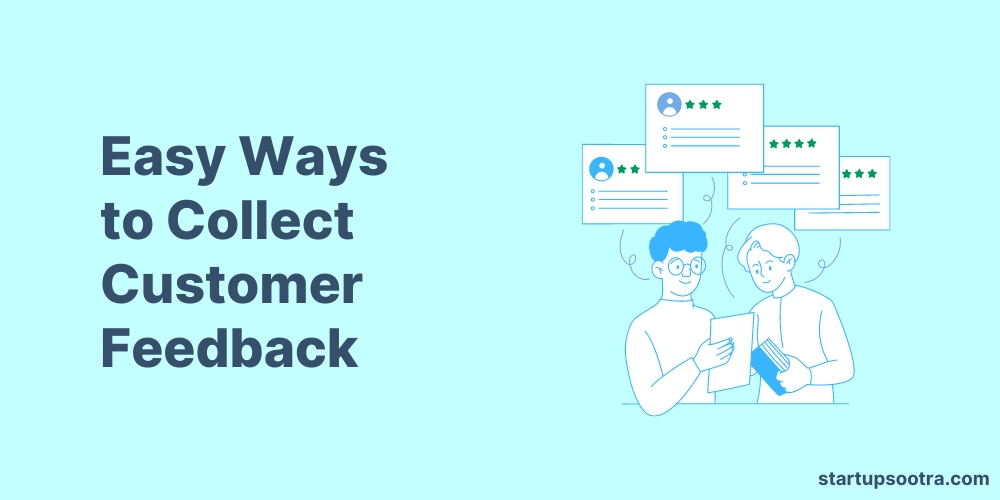Customer feedback is one of the most important in any business to improve the product, service, and customer trust. Whether you are a startup or an established business, customer feedback always helps you make positive changes, improve quality, and build stronger connections with your customers.
In this blog post, I have told you how to collect customer feedback to connect with them. I have also mentioned the best 7 methods to collect feedback in your business.
Let’s get started:
Benefits of Collecting Customer Feedback
Collecting customer feedback offers numerous benefits. Here are some key benefits of it:
- Obtaining valuable insights into customer needs and preferences
- Identifying areas for product or service improvement
- Increasing customer satisfaction and loyalty
- Driving innovation and the development of new offerings
- Building trust and stronger relationships with customers
- Reducing customer churn
- Making data-driven decisions for continuous improvement
Read Also – How to Start an Online Business: Step-by-Step Guide
7 Easy Ways to Collect Customer Feedback
Feedback provides valuable insights into customer satisfaction, preferences, and areas needing improvement. Here are seven easy and effective ways to gather customer feedback:
1. Online Surveys
Online surveys are a versatile and scalable method for collecting customer feedback, allowing you to quickly reach a broad audience and gain valuable insights.
To create effective surveys, keep them concise to encourage completion, use clear and specific questions to avoid ambiguity, incorporate diverse question types to capture different types of feedback, and always test your survey before widespread distribution to ensure it is user-friendly and yields meaningful data.
2. Social Media Listening
Social media platforms are a goldmine for real-time customer feedback. By actively monitoring channels like Twitter, Facebook, and Instagram, businesses can gauge public sentiment about their brand and products, address concerns promptly, and even identify emerging trends.
To effectively leverage social media for feedback, businesses should utilize social listening tools to track brand mentions and relevant keywords. Actively engaging with users by responding to comments, questions, and reviews demonstrates a commitment to customer satisfaction. Analyzing recurring themes in feedback can highlight areas for improvement and uncover valuable insights that can inform business strategies.
3. Customer Reviews and Testimonials
Customer reviews and testimonials offer valuable insights and significantly impact a brand’s credibility. Positive reviews build trust among potential customers, showcasing the quality of your products or services. Proactively request reviews from satisfied customers on platforms like Google, Yelp, or your website.
Showcase these glowing testimonials on your website and marketing materials to attract new customers. Remember to respond to all reviews, both positive and negative, to show your dedication to customer satisfaction and continuous improvement.
4. Email Surveys
Email surveys are a powerful tool for gathering detailed feedback directly from customers. To maximize response rates, segment your audience to ensure surveys are tailored to specific customer groups, making them more relevant and engaging.
Personalize emails by using the recipient’s name and tailoring the content to their interests or purchase history. Additionally, incentivizing participation with small rewards or discounts can further encourage customers to complete your survey.
5. In-App Feedback Forms
In-app feedback forms provide a seamless way for users to share their thoughts and experiences directly within your digital application. By strategically placing simple and visually engaging forms at key points in the user journey, you can gather valuable insights without disrupting their experience.
Keep the feedback forms concise and easy to fill out, using elements like ratings, emojis, or thumbs up/down buttons to encourage participation. Consider placing them after significant interactions, such as completing a purchase or reaching a milestone, to capture feedback when it’s most relevant to the user. This approach allows you to continuously improve your app based on real-time user input.
6. In-Person Interviews
In-person customer interviews offer a unique opportunity to gather detailed qualitative feedback through direct interaction. By scheduling regular interviews with a diverse customer base, businesses can ask open-ended questions that encourage customers to share their experiences in their own words. These rich, nuanced responses can be recorded and analyzed to uncover valuable insights and identify recurring themes, leading to a deeper understanding of customer needs and preferences.
By directly engaging with customers in a conversational setting, businesses can foster stronger relationships, build trust, and gain a more comprehensive understanding of their target audience. This approach not only provides valuable feedback for product development and improvement but also helps businesses connect with their customers on a personal level.
7. Review Sites
Actively seeking customer reviews on platforms like Yelp or Google is crucial for businesses. These platforms serve as hubs for authentic testimonials that potential customers often rely on to make informed decisions. Encourage customers to share their experiences by sending follow-up emails or providing links to review sites after purchase.
Regularly monitoring these platforms allows you to stay informed about customer sentiment and promptly address any concerns. Responding to both positive and negative reviews demonstrates your commitment to customer satisfaction and willingness to improve. It shows that you value customer feedback and are actively working to provide the best possible experience.
Conclusion
These are some best ways of collecting customer feedback. It provides valuable insights into customer needs and satisfaction levels, enabling informed decisions and continuous improvement. Businesses can strengthen customer connections, build trust, and better understand their target audience by actively soliciting feedback given 7 ways to Collect Customer Feedback above. Embracing customer feedback as a fundamental aspect of operations positions businesses for long-term success in today’s competitive landscape.




